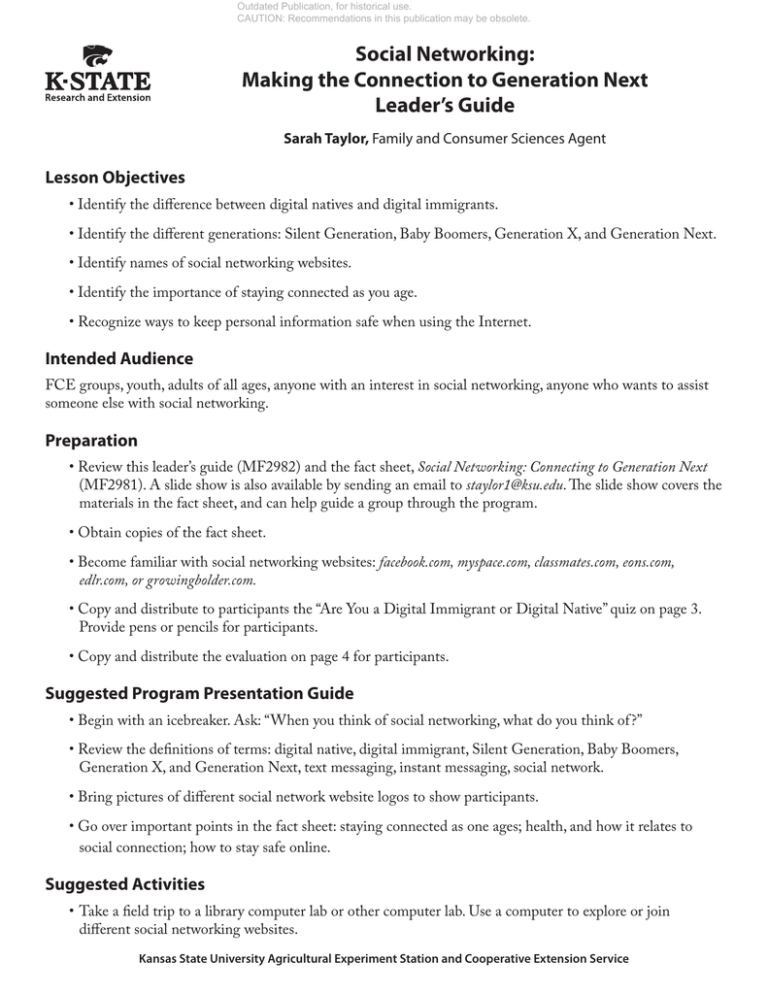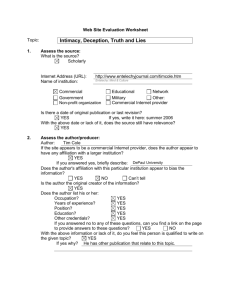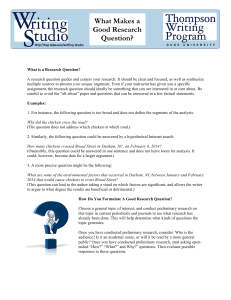
Outdated Publication, for historical use.
CAUTION: Recommendations in this publication may be obsolete.
Social Networking:
Making the Connection to Generation Next
Leader’s Guide
Sarah Taylor, Family and Consumer Sciences Agent
Lesson Objectives
• Identify the difference between digital natives and digital immigrants.
• Identify the different generations: Silent Generation, Baby Boomers, Generation X, and Generation Next.
• Identify names of social networking websites.
• Identify the importance of staying connected as you age.
• Recognize ways to keep personal information safe when using the Internet.
Intended Audience
FCE groups, youth, adults of all ages, anyone with an interest in social networking, anyone who wants to assist
someone else with social networking.
Preparation
• Review this leader’s guide (MF2982) and the fact sheet, Social Networking: Connecting to Generation Next
(MF2981). A slide show is also available by sending an email to staylor1@ksu.edu. The slide show covers the
materials in the fact sheet, and can help guide a group through the program.
• Obtain copies of the fact sheet.
• Become familiar with social networking websites: facebook.com, myspace.com, classmates.com, eons.com,
edlr.com, or growingbolder.com.
• Copy and distribute to participants the “Are You a Digital Immigrant or Digital Native” quiz on page 3.
Provide pens or pencils for participants.
• Copy and distribute the evaluation on page 4 for participants.
Suggested Program Presentation Guide
• Begin with an icebreaker. Ask: “When you think of social networking, what do you think of ?”
• Review the definitions of terms: digital native, digital immigrant, Silent Generation, Baby Boomers,
Generation X, and Generation Next, text messaging, instant messaging, social network.
• Bring pictures of different social network website logos to show participants.
• Go over important points in the fact sheet: staying connected as one ages; health, and how it relates to
social connection; how to stay safe online.
Suggested Activities
•Take a field trip to a library computer lab or other computer lab. Use a computer to explore or join
different social networking websites.
Kansas State University Agricultural Experiment Station and Cooperative Extension Service
Outdated Publication, for historical use.
CAUTION: Recommendations in this publication may be obsolete.
•Hold the class during a break from school and invite grandchildren or
other youth to assist participants in signing up for a social networking
website.
•Ask a business teacher or computer teacher to talk about how social
networking sites can be used.
Glossary of Terms
Silent Generation — Those born before WWII, between 1925 and 1945.
Some members of this generation grew up during the depression, and are the
parents of the baby boomers.
Baby Boomers — Those born after WWII, between 1946 and 1964. These
are the parents of Generation X.
Generation X — Those born from the mid 1960s to about 1981. These are
the parents of Generation Next.
Generation Next — Those born after 1982. Mostly born during the digital
age, this generation is no older than 30 in 2012.
digital native — A young person born between 1982 and 2003, during or
after the introduction of digital technology. They have used digital technology
to communicate with family and friends ever since they were very young, and
are usually comfortable with using technology to communicate.
digital immigrant — A person born before 1982, prior to the introduction
of digital technology and adopted it later in life. Not all digital immigrants
are inept at using technology. These users fall into three categories: avoiders,
reluctant adopters and eager adopters. Avoiders may use only a minimal
amount of technology (for example, a landline phone and a television).
Reluctant adopters often see ways that technology might be needed in their
lives, but they try to avoid it when possible (examples: send letters instead
of email, basic cell phone). Eager adopters have enthusiasm or a talent for
technology that makes them similar to digital natives. Similarly, not all digital
natives are comfortable with technology.
text messaging — Text message are short (160 characters or less) messages
sent between two mobile telephones. This type of message is most often used
between two private mobile phone users as a substitute for a voice call.
instant messaging — A form of real time text-based messages between two
or more people using personal computers, via an Internet connection.
social network — Social network sites are Web-based services that allow
users to construct a public or semi-public profile within the system. Users
share unique information through their profiles, including interests, hobbies,
favorite music and movies. Social network users connect with people they
know in real life by “friending” them. These “friends” then have access to each
other’s profiles and can communicate through the social network site.
Quiz Scoring
Column 1 (Digital Immigrant)
If you answered “Yes” to 12 to 15 of
these questions, you are a digital
immigrant. Few or no digital natives
can communicate with you.
If you answered “Yes” to 9 to 11 of
these questions, you are a digital
immigrant. Most digital natives can
communicate with you with effort.
If you answered “Yes” to five to eight
of these questions, you are a digital
immigrant with an accent. Most
digital natives understand you.
If you answered “Yes” to four or
fewer of these questions, you are
either a digital native, or a digital
immigrant with very little accent.
Column 2 (Digital Native)
If you answered “Yes” to 12 to 15 of
these questions, you are a digital
native or are an immigrant with
very little or no accent.
If you answered “Yes” to 9 to 11 of
these questions, you are a digital
native with an accent; however,
everyone can understand you
perfectly.
If you answered “Yes” to five to eight
of these questions, you are a digital
immigrant with an accent. Most
digital natives understand you.
If you answered “Yes” to four or
fewer of these questions, digital
natives might have a hard time
communicating with you.
Outdated Publication, for historical use.
CAUTION: Recommendations in this publication may be obsolete.
QUIZ: Are you a Digital Immigrant or Digital Native?
___ Do you print your email?
___ Do you wonder why anyone would print an email?
___ Do you print documents to edit them?
___ Do you read the text before looking at the pictures?
___ Do you do every draft from first to last on the
computer and maintain only one copy of any
document?
___ Do you prefer to do one thing at a time?
___ Do you look at the pictures before reading the text?
___ When you want to learn, do you set aside time for
serious work?
___ Do you listen to music, check your email, and chat at
the same time?
___ Do you want to learn new things step-by-step and all
at once?
___ When you want to learn, do you find a game to play?
___ Do you often dial a phone?
___ Have you ever called someone to see if they received
your email?
___ Do you like silence when you’re trying to learn?
___ Do you believe that fundamentals of your subject are
the most important “things” to learn?
___Do you prefer your reading materials to be linear and
sequential?
___ Do you prefer to use the same computer and/or
software every time when you have to complete a
digital task?
___Does this kind of writing drive you nuts?! “BTW. AYT?
Can u rd splng n ur txts?”
___ Do you feel a little “freaked out” when you hear words
like Blog, Glog, Tweet, Web 2.0 or .jpg, .html, .mp3?
___ Do you wish students could just learn like you did
when you were in school?
___ Do you want to learn new things by trying out any/
everything you can think of with no directions? (Just
give me the web address and go away.)
___ Do you rarely dial the phone, vastly preferring to text
message?
___ Are you sure that if the email you send doesn’t bounce
back, the recipient got it, whether or not you get a
response?
___ Do you like to listen to music and/or watch videos
(that may or may not be related to the content you’re
using) while you learn?
___ Do you believe that the fundamentals of your subject
can all be found anywhere at any time by just about
anyone?
___ Do you prefer your reading materials to be hyperlinked
and dynamic?
___ Can you use any computer or software to complete a
digital task as long as it is online?
___ Is this txt k w/u?
___ When you hear words like Blog, Glog, Tweet, Web 2.0
or .jpg, .html, .mp3, do you know exactly how to find
out what they mean?
___ Do you wish your teachers would teach the way you
learn outside of school?
http://urenglishteacher.blogspot.com/2009/06/are-you-digital-native-or-digital.html
Outdated Publication, for historical use.
CAUTION: Recommendations in this publication may be obsolete.
Social Networking: Making the Connection to Generation Next — Evaluation
Date of Program: ________________
Program Location: ________________
Instructor: ______________________
1. Because of my participation in Social Networking: Making the Connection to Generation Next, I learned something new.
(Circle one.)
Yes
No
2. If yes, what did you learn?
3. Because of your participation in this program, do you plan to take any action or change anything in your life?
(Circle one.)
Yes
No
4. If yes, what will you change?
5. For the following questions, please place a check in the appropriate box.
Definitely true
More false
than true
In between
More true
than false
Definitely true
Because of this program, I have more positive
feelings about this topic.
Overall, I rate this program as excellent.
Overall, I rate this instructor as an excellent
teacher.
Please send evaluations to: Sarah Taylor, K-State Research and Extension – Sedgwick County, 7001 W. 21st St. N, Wichita, KS 67205
Brand names appearing in this publication are for product identification purposes only. No endorsement is intended,
nor is criticism implied of similar products not mentioned.
Publications from Kansas State University are available at: www.ksre.ksu.edu
Publications are reviewed or revised annually by appropriate faculty to reflect current research and practice.
Date shown is that of publication or last revision. Contents of this publication may be freely reproduced for educational purposes.
All other rights reserved.
In each case, credit Sarah Taylor, Family and Consumer Sciences Agent,
Social Networking: Making the Connection to Generation Next, Leader’s Guide, Kansas State University, July 2011
Kansas State University Agricultural Experiment Station and Cooperative Extension Service
MF2982
July 2011
K-State Research and Extension is an equal opportunity provider and employer. Issued in furtherance of Cooperative Extension Work, Acts of May 8 and June 30, 1914,
as amended. Kansas State University, County Extension Councils, Extension Districts, and United States Department of Agriculture Cooperating, Gary Pierzynski, Interim
Director.




